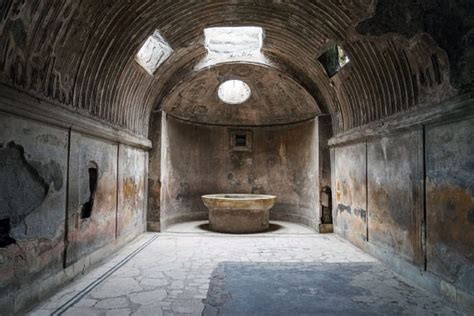Deep in the heart of southern Italy lies the ancient city of Pompeii, a place frozen in time by the catastrophic eruption of Mount Vesuvius in AD79. For centuries, this archaeological treasure trove has captivated explorers and historians alike, offering glimpses into the opulent lifestyles and tragic fates of its inhabitants.
Recently, a team of dedicated archaeologists made an extraordinary find that has been hailed as a “once-in-a-century” discovery. Buried beneath layers of volcanic debris for over 2,000 years, a sumptuous private bathhouse was unearthed within the ruins of Pompeii. This magnificent complex stands as a testament to the lavish indulgence and sophisticated taste of ancient Roman society.
“It’s these spaces that really are part of the ‘Pompeii effect’ – it’s almost as if the people had only left a minute ago,”
remarked Dr Gabriel Zuchtriegel, director of the Archaeological Park of Pompeii, reflecting on the sense of timelessness preserved within these ancient walls.
Imagine stepping back in time to an era where grandeur and elegance defined everyday life. The newly discovered bathhouse boasts not only hot and warm rooms but also a massive plunge pool where up to 30 people could luxuriate at once. Intricately designed with vibrant red walls, mosaic floors, and exquisite artwork depicting scenes from daily life, this oasis offers a glimpse into the leisurely pursuits enjoyed by Pompeii’s elite residents.
As visitors traverse through different chambers – from the soothing heat of sauna-like rooms to the refreshing coolness of marble-lined pools – they can almost feel themselves transported back to an era where relaxation and rejuvenation were paramount. The meticulous attention to detail in every corner speaks volumes about the refined tastes and advanced engineering skills prevalent in ancient Rome.
“This is a dramatic place, and everything you find here tells you about the drama.”
These words from Dr Ludovica Alesse, Pompeii conservator, underscore the poignant stories waiting to be unraveled within these ancient walls. The discovery of two skeletons within this opulent setting serves as a stark reminder of the tragic events that befell Pompeii during that fateful eruption.
The skeletons paint a harrowing picture – one of desperation and sorrow as individuals sought shelter but ultimately succumbed to nature’s wrath. A woman clutching onto precious possessions alongside a younger man underscores the human tragedy immortalized in ash and stone.
Expert analysis sheds light on their identities – perhaps revealing social hierarchies and personal connections that transcended even in moments of calamity. Were they lovers separated by fate or master-servant linked by duty? These unanswered questions add layers to Pompeii’s enduring mystery.
Beyond its luxurious façade lies another reality – one marked by stark inequalities between rich and poor. While elites reveled in decadence within their grandiose abodes, unseen laborers toiled tirelessly behind-the-scenes to maintain such opulence. The juxtaposition between elaborate bathing rituals and grueling furnace operations highlights societal disparities ingrained in Roman culture.
Through ongoing excavations like those at Pompeii emerges not just artifacts but narratives woven from fragments left behind by time itself. Each discovery unravels new chapters in history while inviting us to ponder our own legacy amidst civilizations long past.
As we marvel at these remnants from antiquity – be it shimmering gold coins or intricately carved jewels– we are reminded that human experiences transcend epochs; touching upon shared aspirations for beauty, comfort, and meaning across generations.
In conclusion,
the unfolding saga within Pompeii continues tantalizing visitors with tales both glorious
and somber,
reminding us that beneath every ruin lies
a story waiting to be told,
echoing through
the corridors
of time.





Leave feedback about this